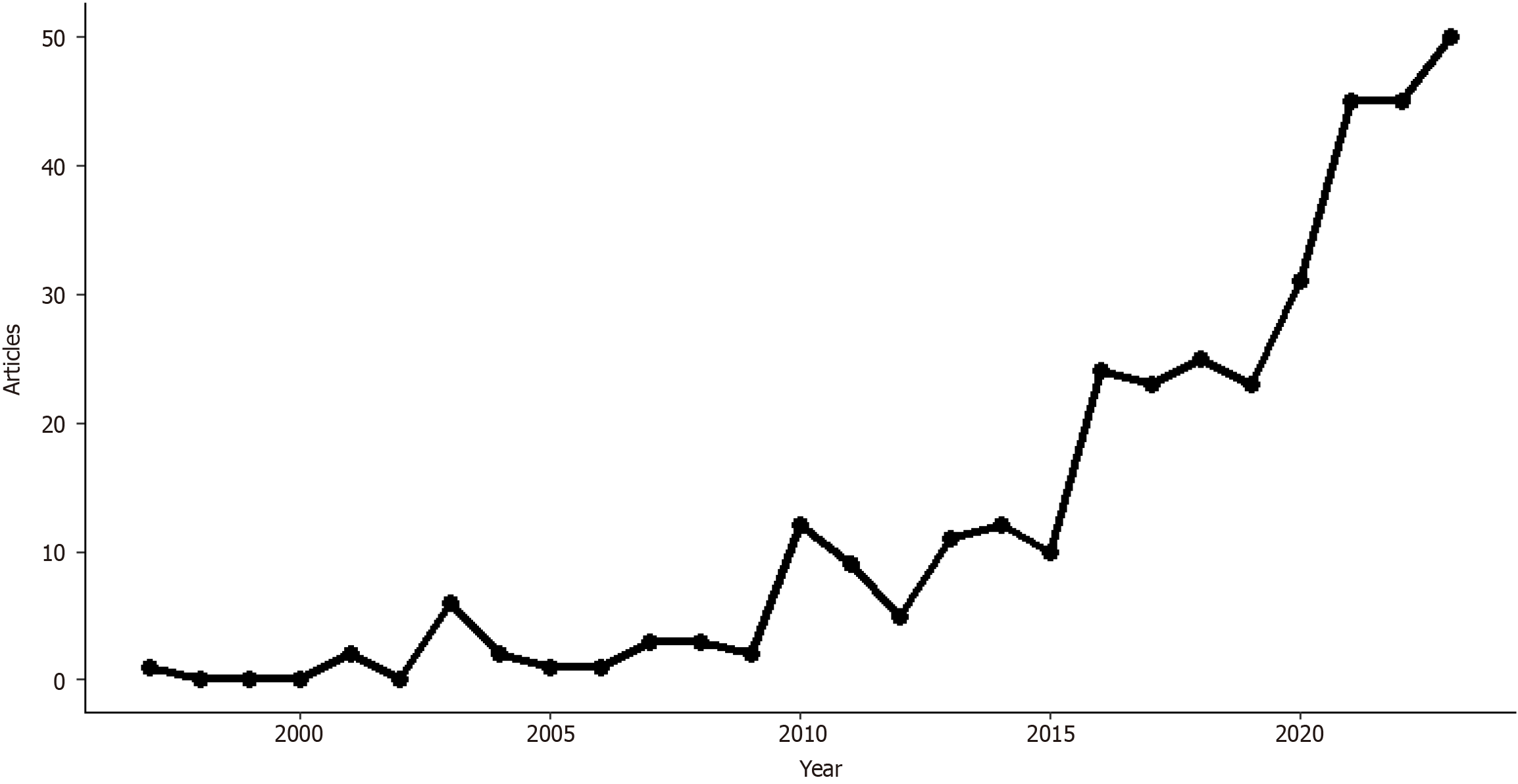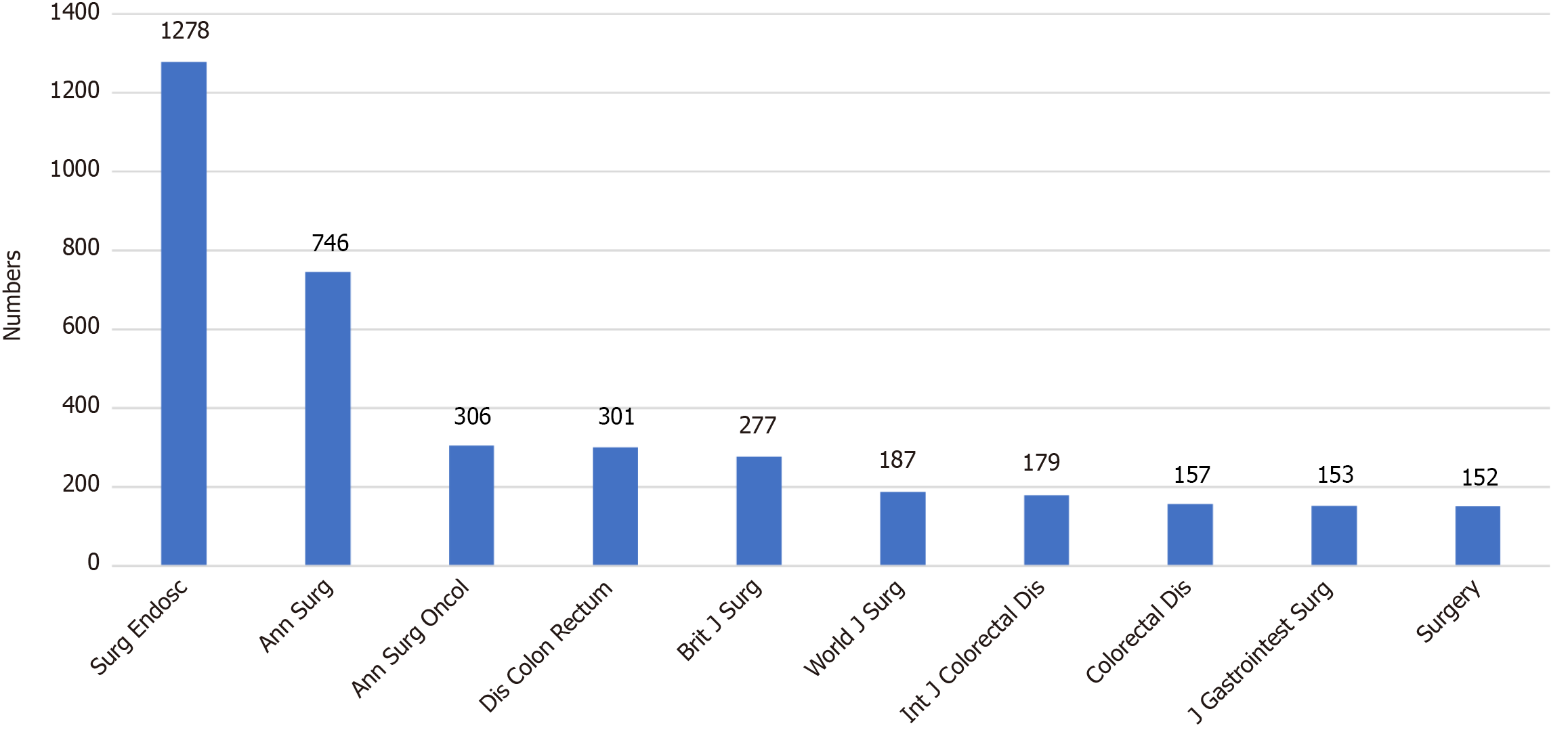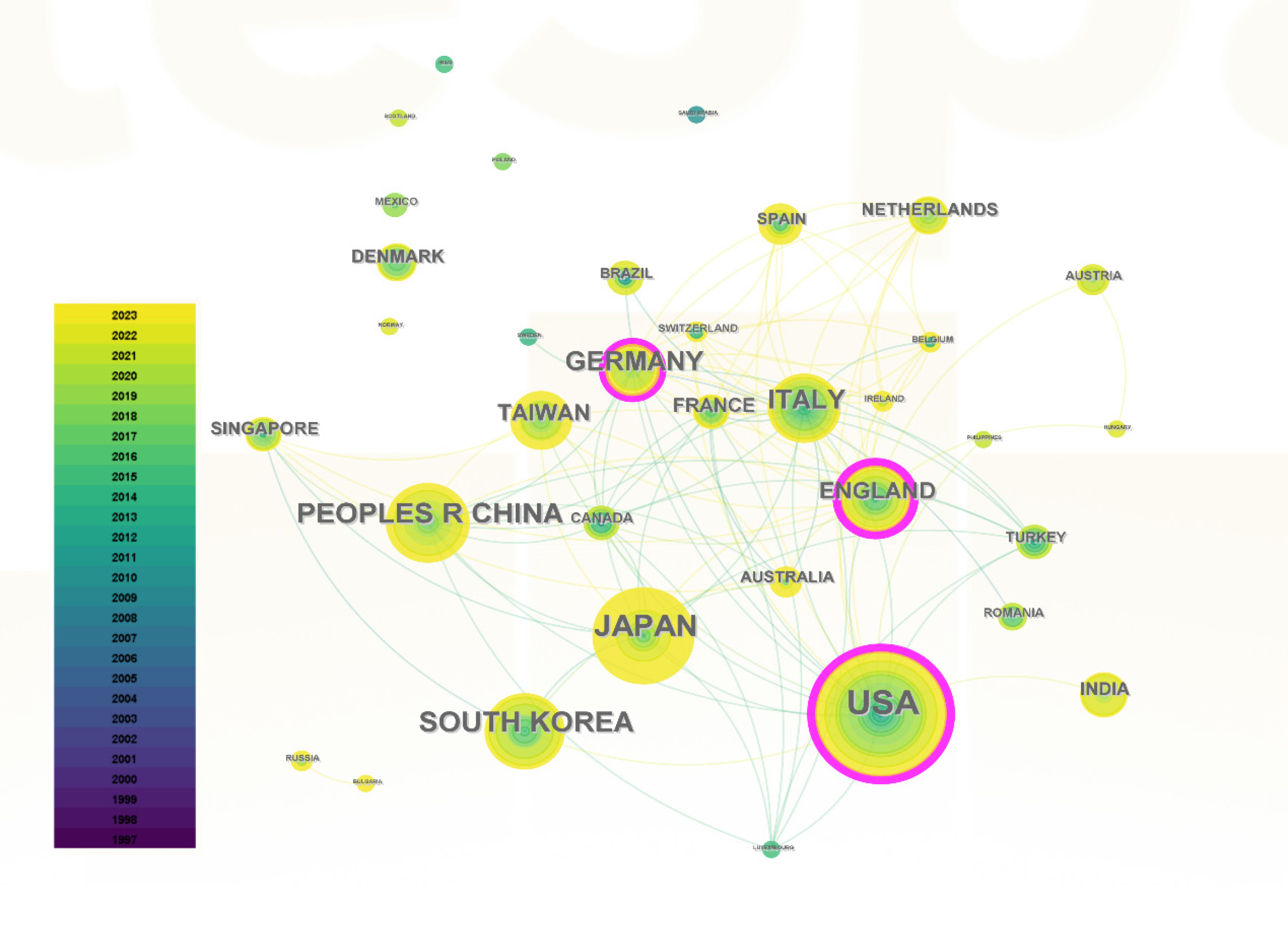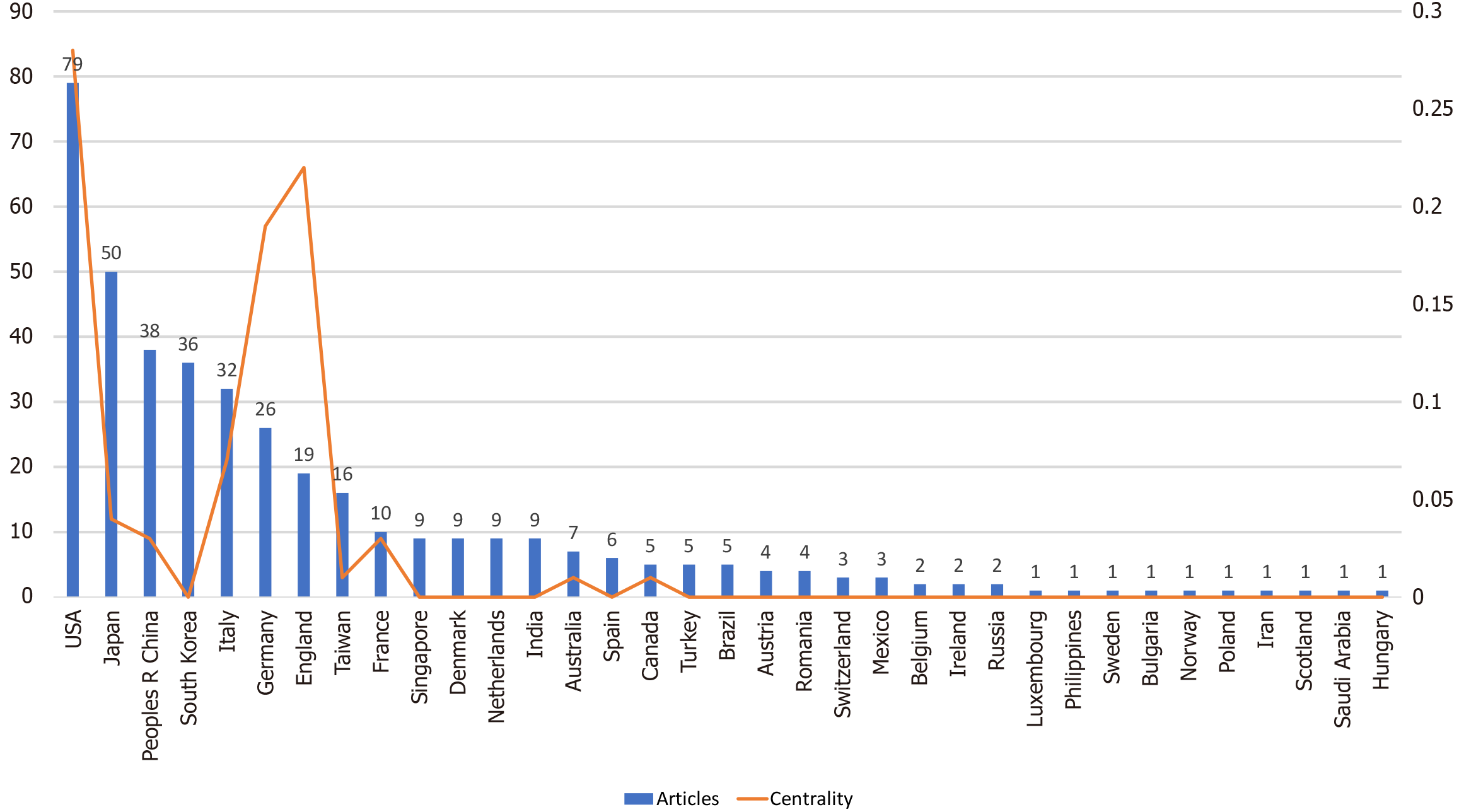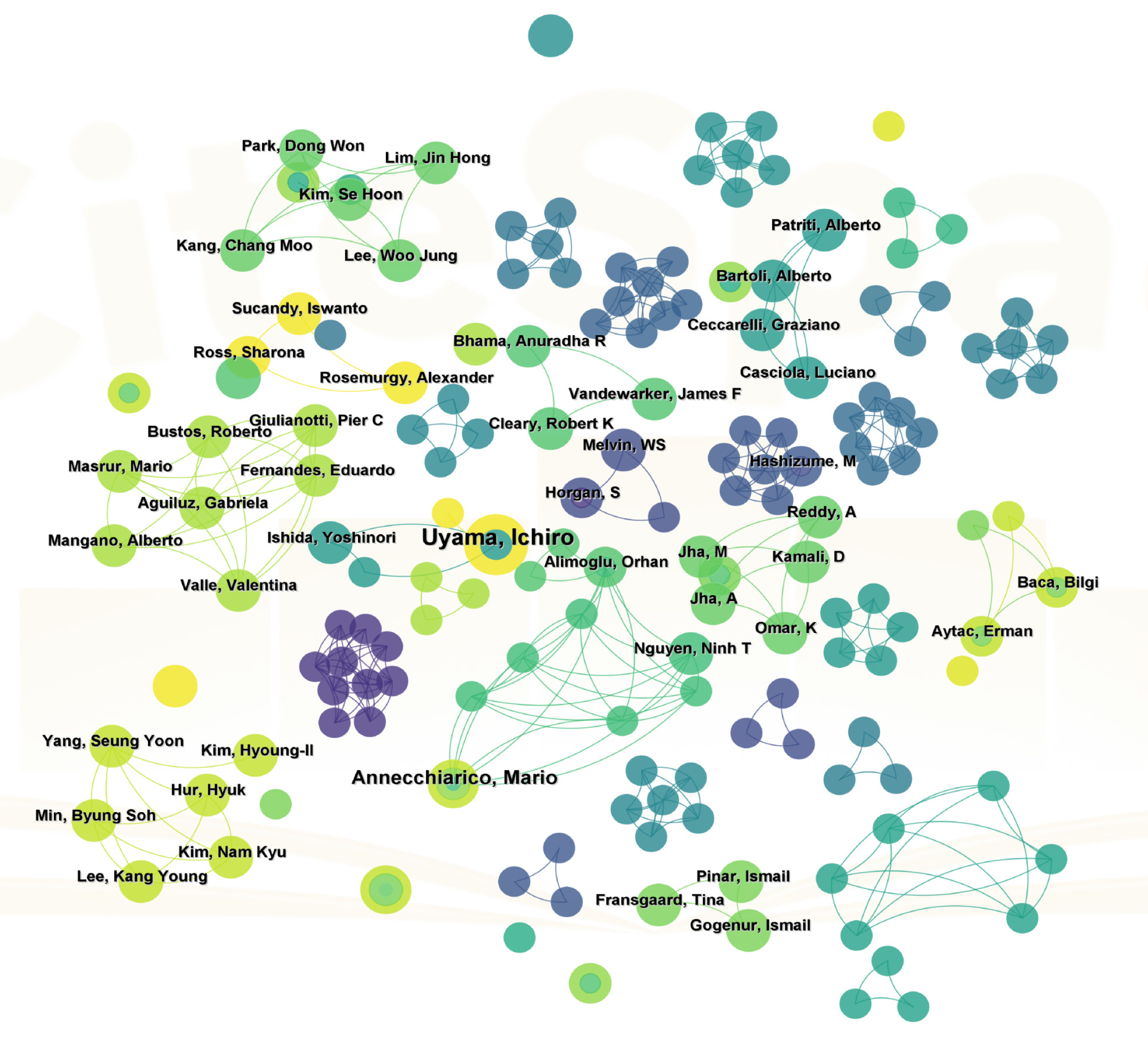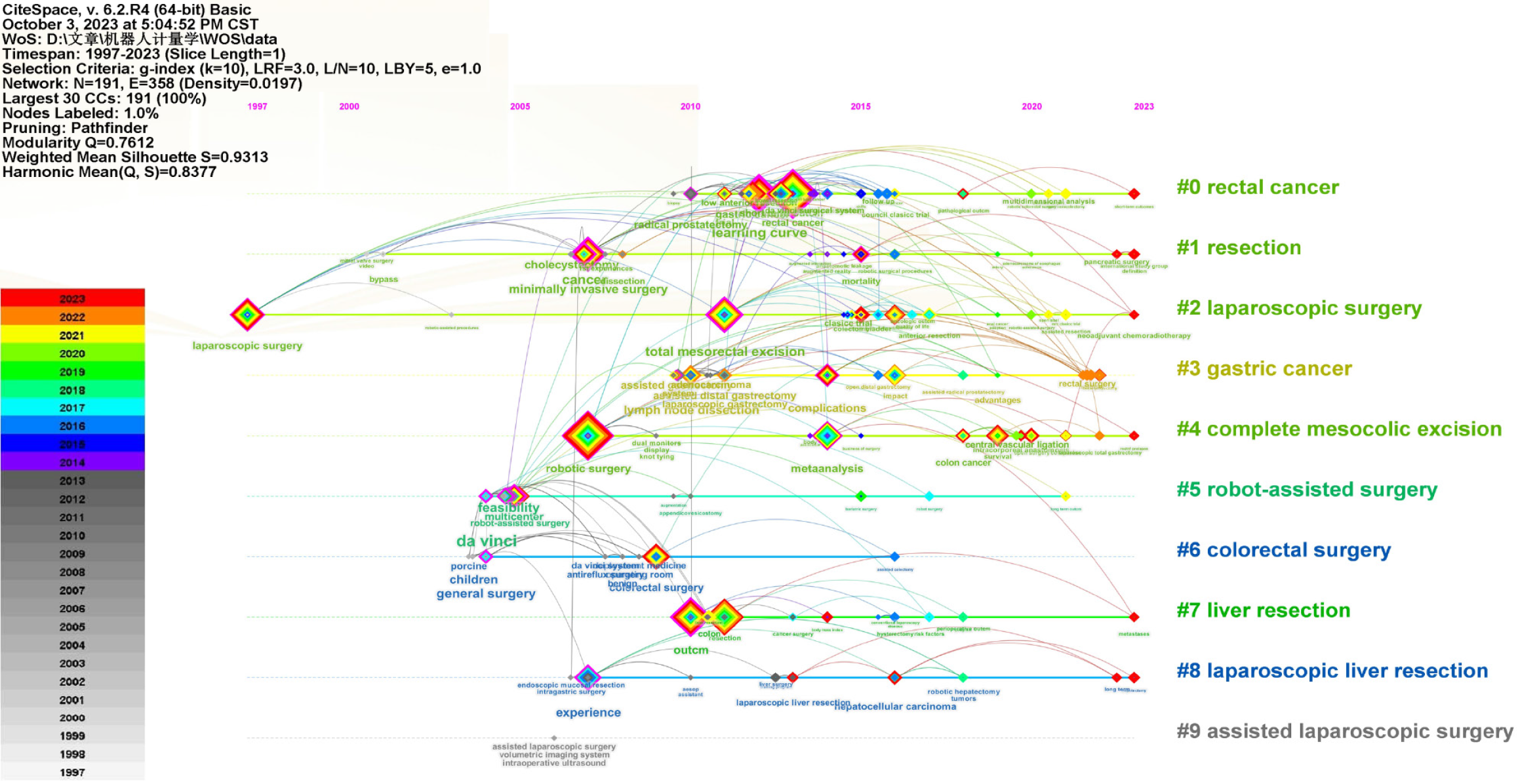Published online Sep 27, 2024. doi: 10.4240/wjgs.v16.i9.3008
Revised: July 20, 2024
Accepted: August 7, 2024
Published online: September 27, 2024
Processing time: 170 Days and 5.4 Hours
Robot-assisted gastrointestinal and liver surgery has been an important deve
To illustrate the major areas of research and forward-looking directions over the past twenty-six years.
Using the Web of Science Core Collection database, a comprehensive review of scholarly articles pertaining to robot-assisted gastrointestinal and liver surgery was researched out between 2000 and 2023. We used Citespace (Version 6.2.4) and Bibliometrix package (Version 4.3.0) to visualize the analysis of all publications including country, institutional affiliations, authors, and keywords.
In total, 346 articles were retrieved. Surgical Endoscopy had with the largest num
The scientific interest in robot-assisted gastrointestinal and liver surgery has experienced a significant rise since 1997. This study provides new perspectives and ideas for future research in this field.
Core Tip: A total of 346 articles were enrolled. This study presents the first bibliometric analysis in the field of robot-assisted surgery system in gastrointestinal and liver surgery. The prominent words shown low anterior resection has proceeded presently, reflecting that related research is still a key trend in gastrointestinal and liver robotic surgery in the future. The United States is the leading country in the number of publications, Yonsei University is the most productive institution. The current focus of this field is on rectal surgery, long-term prognosis, perioperative management.
- Citation: Jin ZC, Wang ZQ. Trend of robot-assisted surgery system in gastrointestinal and liver surgery: A bibliometric analysis. World J Gastrointest Surg 2024; 16(9): 3008-3019
- URL: https://www.wjgnet.com/1948-9366/full/v16/i9/3008.htm
- DOI: https://dx.doi.org/10.4240/wjgs.v16.i9.3008
Robot-assisted surgery is a recent medical method that uses robotic technology to assist surgeons in performing surgical operations and has the advantages of being more precise, less invasive, and more convenient[1]. It can improve surgical outcomes and safety, shorten the recovery time of patients, and reduce the fatigue and radiation damage to surgeons[2].
The history of robot-assisted surgery could be traced back to 1985, when a doctor in Los Angeles, utilized the me
Robot-assisted surgery has unique advantages in gastrointestinal and liver surgery. As rectal cancer surgery requires fine lymph node dissection and intestinal anastomosis in a narrow pelvic space, conventional laparoscopic surgery has certain limitations and challenges. Robot-assisted surgery can provide a stable high-definition three-dimensional image system and a flexible operation system, achieve smooth and accurate movements, and completely remove the lesion[5]. Robot-assisted surgery can diminish anastomotic fistulas, protect autonomic nerves, and increase the anal preservation rate[5]. Liver surgery requires precisely separation and resection of the hepatic portal area with rich blood vessels and complex anatomy, which poses certain risks and difficulties for traditional open or laparoscopic surgery. Robot-assisted surgery can provide a better view and operation angle, accomplish more exact margin control, and reduce bleeding and other complications[6].
Although robot-assisted surgery has obvious technical advantages in gastrointestinal and liver surgery, it also faces a few shortcomings and challenges such as high cost, long operation time, steep learning curve, and insufficient clinical evidence, etc.[7]. The existing research contents are scattered, but it is also one of the fastest developing and most concerning fields in surgical operations. It is fundamental to combine various scientific measurement methods to conduct the in-depth mining and analysis of literature data. In this manner, this study uses bibliometric software to sort and analyze the research hotspots, evolution process, and development context of robot-assisted surgery systems in gas
To investigate the dynamics and evolution trajectory of robot-assisted surgery in gastrointestinal and liver surgery, we conducted a study on journal literature based on the aspects of publication journals, countries, authors, institutions, prominent words, and keywords. The information mining is carried out to summarize the development characteristics of the research and to provide a critical reference for researchers to conduct relevant theoretical research.
All literature data used in this study are from the core database of Web of Science, an important global academic database. The journal time span is set from 1997 to 2023, and the search criteria is: TI = (robot surgery OR robot assisted surgery OR robotic surgical OR robotic surgery) AND [TS = (Liver OR Hepatocellular OR Hepatic) OR TS = (stomach OR gastric OR colorectal OR colon OR rectal OR intestinal OR gastrointestinal OR gastroenterology)], document type = "ARTICLE”.
We used Citespace (Version 6.2.4) and Bibliometrix package (Version 4.3.0) in R software (Version 4.1.2) to visualize the analysis of all publications, using text information extraction strategy, qualitative and quantitative combination method, mining out the current hotspots of robot-assisted surgery in gastrointestinal and liver surgery worldwide, and revealing its network visualization maps, cluster analysis, and burst words.
After searching the literature on robot-assisted surgery in gastrointestinal and liver surgery in the WOS database, we conducted a descriptive analysis of 346 journal articles on this field. From Figure 1, it can be seen that the volume of literature on robot-assisted surgery in gastrointestinal and liver surgery from 1997 to 2023 appeared to be expanding annually, and from 2015 to 2023, the volume of literature in related fields showed a rapid upward trend. In 2001, the Food and Drug Administration approved the Da Vinci robotic surgical system to enter the operating room, and international research on robotic surgery has risen. However, the research results were rare[8], which was primarily affected by two aspects: On the one hand, the essential research about surgical technology in worldwide needed to be progressed, and on the other hand, the limitations of instruments, software, and price had not been widely popularized. It wasn't until 2010 that the number of articles began to increase.
Figures 2 and 3 showed the journals with the most published papers and the most cited journals, respectively. Surgical Endoscopy was positioned to begin with in both the number of published papers and the number of citations and was widely favored by relevant researchers. Two journals related to robotic surgery, Journal of Robotic Surgery and International Journal of Medical Robotics and Computer Assisted Surgery, were ranked second and third in terms of the number of published articles. Even though Annals of Surgery, Annals of Surgical Oncology and British Journal of Surgery did not have a high number of published articles, their published articles were widely recognized by researchers for their quality, so their citations were also among the top five.
In Figure 4, each node represents a country and the connection between the two nodes represents the connection between the two countries. The size of each node equals to the number of publications.
To better obtain the node hierarchy in this field, assist data mining was performed, as shown in Figure 5. From the viewpoint of articles output, the United States and Japan had published the most research on robot-assisted surgery in gastrointestinal and liver surgery, followed by China, South Korea, and Italy, with little difference in paper numbers. Among them, the United States and Italy started their research earlier in this field, and some of their papers were key turning points in the research, which may be a critical reason for their rapid improvement in robot-assisted gastroin
A distribution map of high-output institutions could be obtained by running the software and selecting the "Institution" option. The collaboration map of high-output institutions had 277 nodes and 385 links. Each node represents the number of papers in the institution, and the connect speaks to the collaboration between institutions. Supplementary Figure 1 shows that there was a lack of cooperation among various institutions, and institutions generally cooperate with their own affiliated hospitals or other subordinate institutions, mainly using internal resources for independent research, and lack multi-center and multi-regional research cooperation. The high-output research institutions were Yonsei University, Korea University, University of Illinois System and the others were listed in Table 1.
| Institution | Year of first publication | Number of articles |
| Yonsei University Health System | 2017 | 7 |
| Yonsei University | 2017 | 7 |
| Korea University Medicine (KU Medicine) | 2011 | 6 |
| Korea University | 2011 | 6 |
| University of Illinois System | 2001 | 5 |
| George Washington University | 2016 | 5 |
| Central South University | 2017 | 5 |
| University of California System | 2003 | 5 |
| University of Illinois Chicago | 2001 | 5 |
| Fujita Health University | 2011 | 5 |
| University of Illinois Chicago Hospital | 2001 | 5 |
| Advent Health | 2013 | 4 |
| Amrita Vishwa Vidyapeetham | 2020 | 4 |
| National Taiwan University | 2014 | 4 |
| University of Texas System | 2020 | 4 |
| Azienda Ospedaliero Universitaria Careggi | 2015 | 4 |
| Cleveland Clinic Foundation | 2012 | 4 |
| Adventist Health Services | 2013 | 4 |
| Fujian Medical University | 2018 | 4 |
| Amrita Vishwa Vidyapeetham Kochi | 2020 | 4 |
| Institutul Clinic Fundeni | 2016 | 3 |
| Charité University Berlin Medical School | 2008 | 3 |
| University of California Irvine | 2003 | 3 |
| IRCCS European Institute of Oncology (IEO) | 2011 | 3 |
| National Taiwan University Hospital | 2014 | 3 |
| National University of Singapore | 2010 | 3 |
| Hopital Universitaire Hotel-Dieu-APHP | 2016 | 3 |
| Herlev and Gentofte Hospital | 2013 | 3 |
| Istanbul Medeniyet University | 2013 | 3 |
| Technical University of Munich | 2015 | 3 |
| Hopital Universitaire Paul-Brousse - APHP | 2016 | 3 |
| Chinese People's Liberation Army General Hospital | 2016 | 3 |
| Tianjin University | 2017 | 3 |
| University of North Carolina | 2001 | 3 |
| Imperial College London | 2003 | 3 |
| Assistance Publique Hopitaux Paris (APHP) | 2016 | 3 |
| Ajou University | 2010 | 3 |
| Autonomous University of Barcelona | 2022 | 3 |
| University of Copenhagen | 2013 | 3 |
| Shizuoka Cancer Center | 2014 | 3 |
| Carol Davila University of Medicine & Pharmacy | 2016 | 3 |
| Chinese University of Hong Kong | 2016 | 3 |
| Intuitive Surgical | 2020 | 3 |
| Army Medical University | 2014 | 3 |
To better reflect the core authors and relevance of robot-assisted surgery in gastrointestinal and liver surgery, a visual analysis of author collaboration maps was performed on 346 papers. In total, 230 authors had published articles. The authors with the highest number of publications were Uyama Ichiro, Mario Annecchiarico, and Enrico Andolfi, who published four, three, and three papers, respectively. 53 authors published two papers each (Table 2), and most authors published one paper. The size of the nodes in Figure 6 represents the number of papers published by the author and the link represents the mutual collaboration relationship. The cooperative relationship of authors was relatively close, and the research force in this field was in a moderately concentrated state. The close contact between researchers within the same research institution encompasses a certain note for the in-depth exploration of this field.
| Author | Year of first publication | Number of articles |
| Ichiro Uyama | 2011 | 4 |
| Mario Annecchiarico | 2015 | 3 |
| Enrico Andolfi | 2017 | 3 |
| Valentina Valle | 2020 | 2 |
| Anuradha R Bhama | 2016 | 2 |
| Luciano Casciola | 2011 | 2 |
| Ismail Gogenur | 2018 | 2 |
| Pier C Giulianotti | 2020 | 2 |
| Makoto Hashizume | 2003 | 2 |
| Omar Kadri | 2017 | 2 |
| Alberto Mangano | 2020 | 2 |
| Ismail Pinar | 2018 | 2 |
| Paolo Dario | 2010 | 2 |
| Kang-young Lee | 2021 | 2 |
| Nam-kyu Kim | 2021 | 2 |
| Sharona Ross | 2023 | 2 |
| Hyoung-Il Kim | 2021 | 2 |
| Wanda Petz | 2016 | 2 |
| Tina Fransgaard | 2018 | 2 |
| Alexander Rosemurgy | 2023 | 2 |
| Sam Atallah | 2013 | 2 |
| Robert K Cleary | 2016 | 2 |
| Ajay Varun Reddy | 2017 | 2 |
| Alberto Bartoli | 2011 | 2 |
| Dong-won Park | 2017 | 2 |
| W. Scott Melvin | 2003 | 2 |
| Hyuk Hur | 2021 | 2 |
| Bilgi Baca | 2018 | 2 |
| Yoshinori Ishida | 2011 | 2 |
| Jin-Hong Lim | 2017 | 2 |
| Eduardo Fernandes | 2020 | 2 |
| Gianandrea Baldazzi | 2013 | 2 |
| Se-Hoon Kim | 2017 | 2 |
| Heiko Aselmann | 2016 | 2 |
| Dariush Kamali | 2017 | 2 |
| Samir Agarwal | 2017 | 2 |
| Mario Masrur | 2020 | 2 |
| Orhan Alimoglu | 2015 | 2 |
| Seung-Yoon Yang | 2021 | 2 |
| Woo-Jung Lee | 2017 | 2 |
| Ninh T Nguyen | 2015 | 2 |
| Erman Aytac | 2018 | 2 |
| Natasha Alvarado | 2016 | 2 |
| Amalanshu Jha | 2017 | 2 |
| Gabriela Aguiluz | 2020 | 2 |
| Yusuke Kinugasa | 2023 | 2 |
| Byung-soh Min | 2021 | 2 |
| Madan Jha | 2017 | 2 |
| Graziano Ceccarelli | 2011 | 2 |
| Roberto Bustos | 2020 | 2 |
| Alberto Patriti | 2011 | 2 |
| Chang-moo Kang | 2017 | 2 |
| Iswanto Sucandy | 2023 | 2 |
| Santiago Horgan | 2001 | 2 |
| Jian-Min Li | 2020 | 2 |
| James F Vandewarker | 2016 | 2 |
The prominent words shown in Figure 7 from 2007 to 2017 incorporated robotic surgery experience, robotic surgery system, robotic surgery, and inter-sphincteric resection; from 2017 to 2019, meta-analysis and robotic surgery feasibility appeared; from 2020 onwards, low anterior resection was performed. These prominent words reflected the developmental context and trends of robot-assisted surgery in gastrointestinal and liver surgery. Among these, low anterior resection has proceeded presently, reflecting that related research is still a key trend in gastrointestinal and liver surgery in the future.
Keywords reflect the interrelationships among various topics expressed in the literature and are the core summary of the article's center. Analyzing keywords is conducive to considering hotspots in this field. According to the keywords with a recurrence more prominent than 10 generated by Citespace software (Table 3), the keyword with the highest frequency was “robotic surgery”, with a frequency of 95 times; followed by “rectal surgery”, with a frequency of 76 times. Keywords with high centrality included “learning curve”, “cancer”, “rectal cancer”, which were also core nodes in the network structure. From the clustering time view (Figure 8), 10 clusters with the most clusters were obtained, with a Q value of 0.891, indicating that the clustering structure is significant and the clustering is good[9]; and an S value of 0.9606 indicates that the clustering results are convincing[10]. From the figure, cluster 2, 8, 9 belonged to the comparison between robotic surgery and laparoscopic surgery appeared the most punctual, and it was still a key research field. Cluster 5 was the only cluster that was associated with robotic surgery. Cluster 0, 3, 6, 7 were associated with the specific surgical sites. Research on colorectal surgery appeared prior, and in 2010-2015, rectal surgery became a research focus, indicating that robotic surgery had unique advantages in rectal surgery and has received wide attention from researchers. Research in the early stage mainly focused on learning curves and short-term outcomes, later progressed to comparative research on multiple dimensions and surgical methods. Robotic surgery of the stomach appeared later than that of the colorectum, and research trends have declined in recent years. Robotic liver surgery was a current research focus. Although compared with gastrointestinal robotic surgery, liver robotic surgery keywords appeared slightly later, the evolution of keywords was clearer, from examining surgical experience in 2005-2010, to gradually developing to study perioperative complications and long-term prognosis.
| Keywords | Year of first occurrences | Frequency | Centrality |
| Robotic surgery | 2007 | 95 | 0.14 |
| Rectal cancer | 2013 | 76 | 0.34 |
| Resection | 2011 | 68 | 0.06 |
| Surgery | 2010 | 57 | 0.06 |
| Outcome | 2010 | 46 | 0.21 |
| Laparoscopic surgery | 1997 | 43 | 0.11 |
| Learning curve | 2012 | 42 | 0.51 |
| Total mesorectal excision | 2011 | 42 | 0.29 |
| Minimally invasive surgery | 2007 | 33 | 0.2 |
| Colorectal surgery | 2009 | 32 | 0.04 |
| Meta analysis | 2014 | 27 | 0.11 |
| Gastric cancer | 2012 | 27 | 0.06 |
| Cancer | 2007 | 26 | 0.38 |
| Short term outcome | 2013 | 23 | 0.1 |
| Experience | 2007 | 22 | 0.23 |
| Complications | 2014 | 22 | 0.17 |
| Colorectal cancer | 2016 | 21 | 0 |
| Robot-assisted surgery | 2005 | 19 | 0.08 |
| Low anterior resection | 2012 | 18 | 0.02 |
| Trial | 2011 | 17 | 0.06 |
| Impact | 2016 | 15 | 0.03 |
| Survival | 2019 | 15 | 0.02 |
| Lymph node dissection | 2010 | 14 | 0.08 |
| Multicenter | 2005 | 13 | 0.23 |
| Colon cancer | 2018 | 10 | 0.04 |
| Classification | 2015 | 10 | 0 |
Robot-assisted surgery in gastrointestinal and liver surgery is an imperative development direction in the field of surgery in later a long time. It uses advanced robotic technology to assist doctors in performing precise, minimally invasive, and safe surgical operations; improving surgical outcomes and patient satisfaction; and providing a new platform and opportunity for surgical education and training[11]. This study used bibliometric methods to systematically analyze and examine 346 articles in the field over the past 26 years.
The number of articles published each year showed an increasing trend, especially in the last 10 years. This showed that robotic surgery has been widely performed, and the technology was becoming increasingly mature. From the perspective of journals, Surgical Endoscopy ranked first in both the number of published papers and the number of citations, demonstrating that this journal had a high impact and authority in robot-assisted surgery in gastrointestinal and liver surgery and reflected the close intersection between this field and endoscopic surgery. Other journals with more papers or citations were mainly concentrated in the fields of surgery, medical engineering, and computer science, reflecting the multidisciplinary and comprehensive nature of this field. An article published in the Annals of Surgery in 2018 that prospectively compared robotic surgery and laparoscopy for rectal cancer again aroused researchers’ enthusiasm, and related articles appeared in the following years[12].
From the perspective of paper output, the United States and Japan have published the most papers on robot-assisted surgery in gastrointestinal and liver surgery, indicating that these two countries have solid research quality and innovation capacity in this field[13,14], and were related to the advanced level of these two countries in robotic tech
From the perspective of high-output institutions and authors, Yonsei University was the most productive institution, and Uyama Ichiro, Mario Annecchiarico, and Enrico Andolfi were the most productive authors, indicating that these institutions and authors had a high academic status and contribution in this field[15]. However, from the perspective of cooperation between institutions and authors, it was not connected closely, mainly based on cooperation within the same institution or between affiliated hospitals, missing cross-institutional, cross-national, and cross-disciplinary cooperation models, which may constrain the knowledge sharing and innovation ability of this field.
From the perspective of research hotspots, the current focus of robot-assisted surgery in gastrointestinal and liver surgery was on rectal surgery, long-term prognosis, perioperative management, previous surgical experience, the learning curve to focus on each disease, and comparison with laparoscopic surgery. It appeared that this field had entered a profound stage from an exploratory stage, paying more attention to the assessment and enhancement of surgical effects and quality, and paying more consideration to the advantages and adaptability of different surgical methods[5,16]. Rectal surgery is a critical branch of this field. Because robotic surgery has self-evident preferences in rectal surgery, such as better vision, more precise operation, and a higher anal preservation rate, it has received wide attention and application. Robotic surgery of the stomach[17] and liver[18] appeared relatively late, and research trends have declined in recent years. This may be related to the anatomical structure and surgical difficulty of these parts. It may also be related to the cost-effectiveness and insufficient clinical evidence of robotic surgery.
Be that as it may, this paper also has some limitations such as single source of literature data, insufficient depth of analysis methods, incomplete conclusions etc., which need to be improved and culminated in future research.
In summary, robot-assisted surgery in gastrointestinal and liver surgeries is a vibrant and promising field. It involves multiple disciplines and fields and has high academic value and social importance. This study used bibliometric methods to systematically analyze and discuss the research status, development trends, and hot issues in this field. This provides modern perspectives and ideas for further research in this field.
| 1. | Mehta A, Cheng Ng J, Andrew Awuah W, Huang H, Kalmanovich J, Agrawal A, Abdul-Rahman T, Hasan MM, Sikora V, Isik A. Embracing robotic surgery in low- and middle-income countries: Potential benefits, challenges, and scope in the future. Ann Med Surg (Lond). 2022;84:104803. [RCA] [PubMed] [DOI] [Full Text] [Full Text (PDF)] [Cited by in Crossref: 57] [Cited by in RCA: 48] [Article Influence: 16.0] [Reference Citation Analysis (0)] |
| 2. | Muaddi H, Hafid ME, Choi WJ, Lillie E, de Mestral C, Nathens A, Stukel TA, Karanicolas PJ. Clinical Outcomes of Robotic Surgery Compared to Conventional Surgical Approaches (Laparoscopic or Open): A Systematic Overview of Reviews. Ann Surg. 2021;273:467-473. [RCA] [PubMed] [DOI] [Full Text] [Cited by in Crossref: 30] [Cited by in RCA: 120] [Article Influence: 30.0] [Reference Citation Analysis (0)] |
| 3. | Ng AT, Tam PC. Current status of robot-assisted surgery. Hong Kong Med J. 2014;20:241-250. [RCA] [PubMed] [DOI] [Full Text] [Cited by in Crossref: 8] [Cited by in RCA: 14] [Article Influence: 1.3] [Reference Citation Analysis (0)] |
| 4. | Goh EZ, Ali T. Robotic surgery: an evolution in practice. J Surg Protoc Res Methodol. 2022;2022. [DOI] [Full Text] |
| 5. | Liu G, Zhang S, Zhang Y, Fu X, Liu X. Robotic Surgery in Rectal Cancer: Potential, Challenges, and Opportunities. Curr Treat Options Oncol. 2022;23:961-979. [RCA] [PubMed] [DOI] [Full Text] [Full Text (PDF)] [Cited by in RCA: 34] [Reference Citation Analysis (0)] |
| 6. | Kose E, Karahan SN, Berber E. Robotic Liver Resection: Recent Developments. Curr Surg Rep. 2020;8:9. [RCA] [DOI] [Full Text] [Reference Citation Analysis (0)] |
| 7. | Lorenzon L, Bini F, Balducci G, Ferri M, Salvi PF, Marinozzi F. Laparoscopic versus robotic-assisted colectomy and rectal resection: a systematic review and meta-analysis. Int J Colorectal Dis. 2016;31:161-173. [RCA] [PubMed] [DOI] [Full Text] [Cited by in Crossref: 57] [Cited by in RCA: 47] [Article Influence: 5.2] [Reference Citation Analysis (0)] |
| 8. | Klodmann J, Schlenk C, Hellings-kuß A, Bahls T, Unterhinninghofen R, Albu-schäffer A, Hirzinger G. An Introduction to Robotically Assisted Surgical Systems: Current Developments and Focus Areas of Research. Curr Robot Rep. 2021;2:321-332. [DOI] [Full Text] |
| 9. | Newman ME. Modularity and community structure in networks. Proc Natl Acad Sci U S A. 2006;103:8577-8582. [RCA] [PubMed] [DOI] [Full Text] [Cited by in Crossref: 8062] [Cited by in RCA: 4028] [Article Influence: 212.0] [Reference Citation Analysis (0)] |
| 10. | Rousseeuw PJ. Silhouettes: A graphical aid to the interpretation and validation of cluster analysis. J Comput Appl Math. 1987;20:53-65. [DOI] [Full Text] |
| 11. | Green CA, Chern H, Rogers SJ, Reilly LM, O'Sullivan P. Transforming Surgical Education through a Resident Robotic Curriculum. Ann Surg Open. 2021;2:e076. [RCA] [PubMed] [DOI] [Full Text] [Cited by in Crossref: 5] [Cited by in RCA: 8] [Article Influence: 2.0] [Reference Citation Analysis (0)] |
| 12. | Kim MJ, Park SC, Park JW, Chang HJ, Kim DY, Nam BH, Sohn DK, Oh JH. Robot-assisted Versus Laparoscopic Surgery for Rectal Cancer: A Phase II Open Label Prospective Randomized Controlled Trial. Ann Surg. 2018;267:243-251. [RCA] [PubMed] [DOI] [Full Text] [Cited by in Crossref: 141] [Cited by in RCA: 233] [Article Influence: 38.8] [Reference Citation Analysis (0)] |
| 13. | Sheetz KH, Claflin J, Dimick JB. Trends in the Adoption of Robotic Surgery for Common Surgical Procedures. JAMA Netw Open. 2020;3:e1918911. [RCA] [PubMed] [DOI] [Full Text] [Full Text (PDF)] [Cited by in Crossref: 229] [Cited by in RCA: 497] [Article Influence: 99.4] [Reference Citation Analysis (0)] |
| 14. | Nishimura K. Current status of robotic surgery in Japan. Korean J Urol. 2015;56:170-178. [RCA] [PubMed] [DOI] [Full Text] [Full Text (PDF)] [Cited by in Crossref: 9] [Cited by in RCA: 11] [Article Influence: 1.1] [Reference Citation Analysis (0)] |
| 15. | Kim JY, Kim WS, Choi EC, Nam W. The Role of Virtual Surgical Planning in the Era of Robotic Surgery. Yonsei Med J. 2016;57:265-268. [RCA] [PubMed] [DOI] [Full Text] [Full Text (PDF)] [Cited by in Crossref: 6] [Cited by in RCA: 6] [Article Influence: 0.7] [Reference Citation Analysis (0)] |
| 16. | Feng Q, Yuan W, Li T, Tang B, Jia B, Zhou Y, Zhang W, Zhao R, Zhang C, Cheng L, Zhang X, Liang F, He G, Wei Y, Xu J; REAL Study Group. Robotic versus laparoscopic surgery for middle and low rectal cancer (REAL): short-term outcomes of a multicentre randomised controlled trial. Lancet Gastroenterol Hepatol. 2022;7:991-1004. [RCA] [PubMed] [DOI] [Full Text] [Cited by in Crossref: 8] [Cited by in RCA: 224] [Article Influence: 74.7] [Reference Citation Analysis (0)] |
| 17. | Ma S, Li L, Yang C, Liu B, Zhang X, Liao T, Liu S, Jin H, Cai H, Guo T. Advances in the application of robotic surgical systems to gastric cancer: A narrative review. Asian J Surg. 2023;46:3027-3032. [RCA] [PubMed] [DOI] [Full Text] [Reference Citation Analysis (0)] |
| 18. | Ma B, Wu S, Liu R, Hu M. Robotic liver resection from exploration to maturity—single center experience. Intell Surg. 2022;5:20-25. [DOI] [Full Text] |









